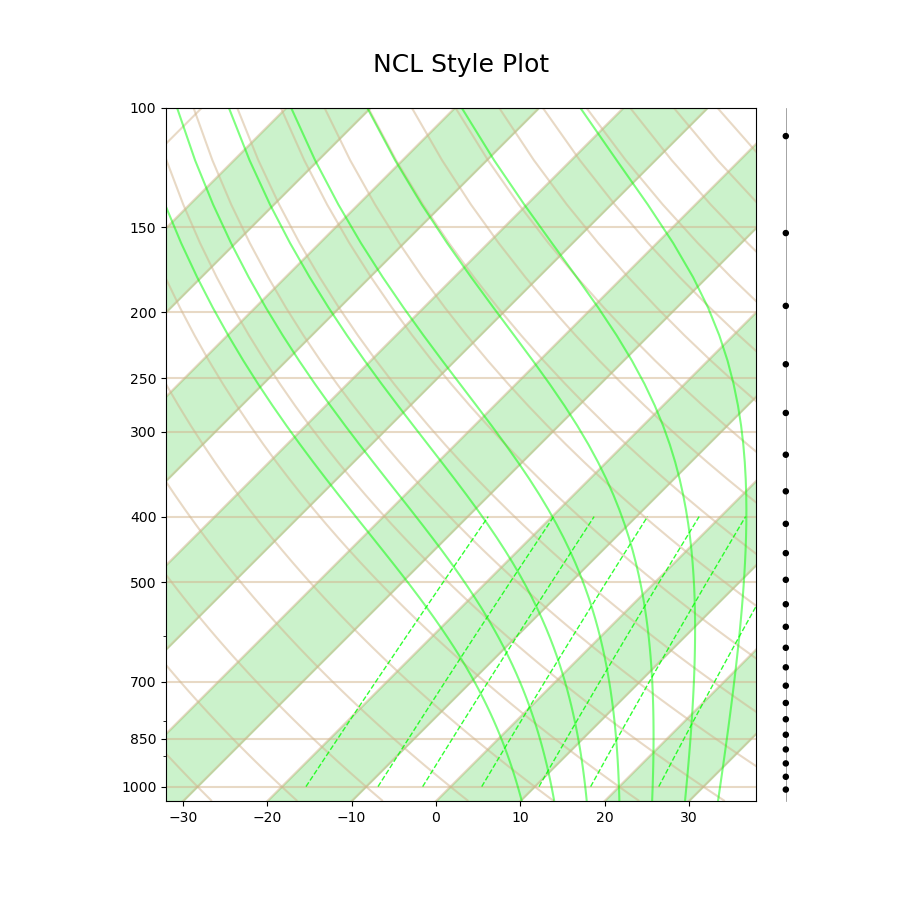Note
Go to the end to download the full example code
NCL_skewt_1.py#
- This script illustrates the following concepts:
Drawing a default Skew-T background
Customizing the background of a Skew-T plot
- See following URLs to see the reproduced NCL plot & script:
Import packages:
import matplotlib.pyplot as plt
import matplotlib.lines as mlines
import numpy as np
from metpy.plots import SkewT
from metpy.units import units
import geocat.viz as gv
Plot Skew-T with MetPy Defaults:
# Note that there are no labels on the axes. This is because we have not yet
# plotted any data. Once data is plotted, MetPy will use the units of the
# data to create appropriate labels.
fig = plt.figure(figsize=(9, 9))
skew = SkewT(fig)
ax = skew.ax
skew.plot_dry_adiabats()
skew.plot_moist_adiabats()
skew.plot_mixing_lines()
gv.set_titles_and_labels(ax, maintitle="MetPy Default Skew-T")
plt.show()

Plot Skew-T that is similar to NCL’s default Skew-T plot:
# Note that MetPy forces the x axis scale to be in Celsius and the y axis
# scale to be in hectoPascals. Once data is plotted, then the axes labels are
# automatically added
fig = plt.figure(figsize=(9, 9))
# The rotation keyword changes how skewed the temperature lines are. MetPy has
# a default skew of 30 degrees
skew = SkewT(fig, rotation=45)
ax = skew.ax
# Shade every other section between isotherms
x1 = np.linspace(-100, 40, 8) # The starting x values for the shaded regions
x2 = np.linspace(-90, 50, 8) # The ending x values for the shaded regions
y = [1050, 100] # The range of y values that the shades regions should cover
for i in range(0, 8):
skew.shade_area(y=y,
x1=x1[i],
x2=x2[i],
color='limegreen',
alpha=0.25,
zorder=1)
# Choose starting temperatures in Kelvin for the dry adiabats
t0 = units.K * np.arange(243.15, 444.15, 10)
skew.plot_dry_adiabats(t0=t0, linestyles='solid', colors='tan', linewidths=1.5)
# Choose starting temperatures in Kelvin for the moist adiabats
t0 = units.K * np.arange(281.15, 306.15, 4)
skew.plot_moist_adiabats(t0=t0,
linestyles='solid',
colors='lime',
linewidth=1.5)
# Choose mixing ratios
w = np.array([0.001, 0.002, 0.003, 0.005, 0.008, 0.012, 0.020]).reshape(-1, 1)
# Choose the range of pressures that the mixing ratio lines are drawn over
p = units.hPa * np.linspace(1000, 400, 7)
# Plot mixing ratio lines
skew.plot_mixing_lines(mixing_ratio=w,
pressure=p,
linestyle='dashed',
colors='lime',
linewidths=1)
# Use geocat.viz utility functions to set axes limits and ticks
gv.set_axes_limits_and_ticks(
ax=ax,
xlim=[-32, 38],
yticks=[1000, 850, 700, 500, 400, 300, 250, 200, 150, 100])
# Use geocat.viz utility functions to add a main title
gv.set_titles_and_labels(ax=ax, maintitle="NCL Style Plot")
# Plot empty wind barbs with dummy data
u = np.zeros(22)
v = u
p = np.linspace(1010, 110, 22)
skew.plot_barbs(pressure=p,
u=u,
v=v,
xloc=1.05,
fill_empty=True,
sizes=dict(emptybarb=0.075, width=0.1, height=0.2))
# Draw line underneath wind barbs
line = mlines.Line2D([1.05, 1.05], [0, 1],
color='gray',
linewidth=0.5,
transform=ax.transAxes,
clip_on=False,
zorder=1)
ax.add_line(line)
# Change the style of the gridlines
plt.grid(True,
which='major',
axis='both',
color='tan',
linewidth=1.5,
alpha=0.5)
plt.show()

Total running time of the script: (0 minutes 0.385 seconds)